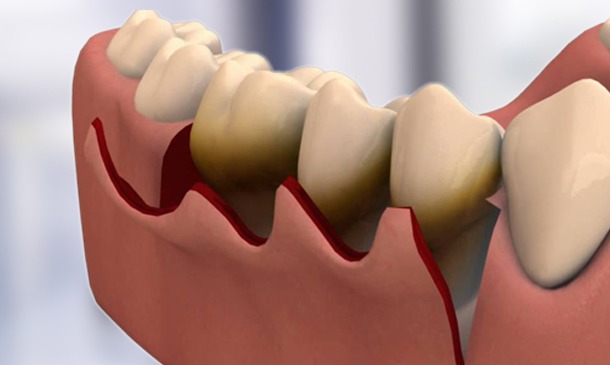Gums Surgery (flap surgery) & Lasers

Periodontal disease develops when bacteria and tartar below the gum line invade and inflame the tissues that support the teeth. Gingivitis is the early stage of periodontal disease and can usually be reversed by daily brushing, flossing, and regular cleaning by a dental professional. Gingivitis can progress to periodontitis, in which the gums peel away from the teeth, leaving crevices (called "pockets") that get infected.
Deepening pockets, typically filled with pus, and swollen gums around the base of the teeth are symptoms of advanced periodontitis. This disorder can cause jaw bone loss and weakening of ligaments that hold teeth in place. If tooth loosening occurs, as a result, tooth extraction will almost certainly be required to keep the illness from spreading. Gum surgery could be necessary for treatment since severe gum disease may not resolve without intervention.
Generally, there are two processes for performing gum surgery. They are traditional flap surgery and laser flap surgery.
LASER-ASSISTED PERIODONTAL FLAP SURGERY USING LANAP:
Laser flap surgery is a single-sitting, painless, bloodless, and stitch less treatment procedure for improving general oral health and recovery time compared to traditional gum surgery or periodontal treatment. Because your gums are not being cut, you will not have any bleeding, stitches, or post-treatment infection. You will also spend less time in the dentist's chair and have fewer follow-up appointments.
Immediately following the treatment, the patient wouldn't be able to tell that he had received any surgery.
The following are the advantages of laser gum treatment:-
- Painless Procedure
- Less Bleeding
- No sutures are required.
- No Cut or Reflection of soft tissue
- Less injury to tissue
- Reduced risk of infection
- Decreased Sensitivity
- Less procedure time
- Less Post-Treatment Discomfort
- Faster Healing
- Bio stimulation of tissues
The procedure for laser gum surgery is:
The LANAP, or laser-assisted new attachment procedure, is often used to treat gum disease.
Here’s what you can expect from laser gum surgery:
- Your periodontist will place the Fiber optic tip of the laser at the top of the periodontal pocket. The laser is about the size of three human hairs.
- The laser will use pinpointed light to remove diseased and inflamed gum tissue from the pocket. (The laser is designed to remove diseased tissue. It does not remove or damage healthy gum tissue. The laser also removes disease-causing germs and bacteria from the periodontal pocket)
- Once the pocket is cleaned of damaged tissue and bacteria, the laser is set aside.
- Your periodontist uses an ultrasonic cleaning tool to break apart and remove tartar and calcifications.
- The laser is reintroduced into the pocket to deep clean the bottom and eliminate tell-tale debris.
- The laser also sterilizes tissue and bone and stimulates the formation of a blood clot. The blood clot speeds healing and help gum tissue reattach to the tooth. Thus, eliminating the need for stitches.
When LANAP Surgery is not an option:
Traditional surgery is necessary in some severe cases of periodontitis. During traditional gum surgery, also known as flap surgery, the dentist uses a scalpel to cut into and peel back gum tissue. A dentist can then access the roots of the teeth for cleaning, bone contouring, and gum tissue cutting. Sutures are used to hold the gums in place. Flap surgery is more painful than LANAP® and requires a longer recovery time due to the gum cutting and suturing.
If you want more information regarding post-operative instructions, consult our dental experts.
Call Us Now or For More Information Click Here